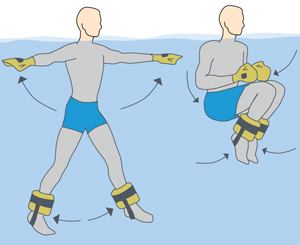Deep-water exercise has been well-documented as a viable alternative to shallow-water and land-based fitness training. A properly designed deep-water workout incorporates all the components of a typical land-based workout, resulting in significant health and fitness benefits for participants.
The use of water as an effective training tool requires manipulating buoyancy and resistance to create work and rest as opposed to using gravity. The ability to manipulate (control) buoyancy and harness (use) water resistance to increase and/or decrease exercise intensity is a learned skill. Water fitness instructors, unlike land fitness instructors, cannot assume their students come to class with this skill.
By definition, deep-water exercise refers to any exercise performed with the body in a vertical position with the lungs submerged. The depth of water is sufficient to prevent participants from rebounding or accelerating off the pool bottom. The human body responds differently to exercise stimulus and movement in the buoyant environment of deep water.
Lack of contact with the ground makes deep-water exercise especially challenging. The negligible force of gravity and the absence of a solid surface to provide a stable base of support create an unstable working environment. This often results in poor body alignment and a marked lack of balance and coordination in the unskilled participant.
Maintaining an upright, vertical and aligned posture (neutral pelvis and spine) is essential to ensure exercise safety and to optimize training benefits. Deep-water exercisers must adjust and learn to stabilize (find and maintain balance) using their center of buoyancy (at the lungs) instead of their center of gravity (in the pelvis).
The ability to find balance between these two points and maintain equilibrium varies from individual to individual and improves with coaching. For these reasons, I’ve found it successful to teach my students the skill of “sculling.”
To reinforce the technique, in the warm-up of segment of class I have them perform a progression of eight exercises that challenge their balance and alignment.
Sculling is how swimmers move through the water. Stationary sculling is a means of vertical propulsion that allows the hands to have a continuous “grip” on the water. In deep-water exercise it is an important skill that enables your students to hold a position, control their movements, achieve balance and maintain postural alignment.
Technically, sculling consists of an outward sweep and an inward sweep of the arms and hands. The hands are angled at 45 degrees with the thumbs down on the outward sweep, and thumbs up on the inward sweep. The movement is not from the hands, but from the elbow with the wrists locked. The motion is smooth, fluid and continuous. It is a complex skill that is best taught using a kinesthetic approach.
The progression of exercises shown on the previous page uses specific body positions and movements that force students to engage their arms and hands to stabilize, as well as recruit their core to maintain balance and alignment.
To enhance proprioceptive feedback, I encourage my students to use webbed resistance gloves.



